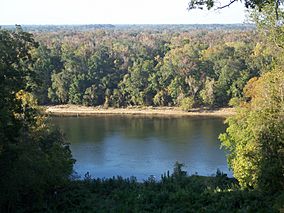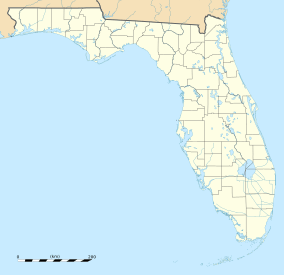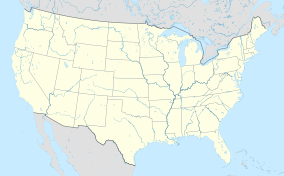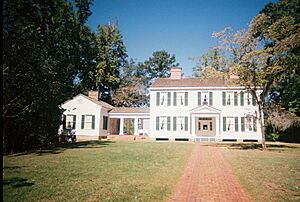Torreya State Park facts for kids
Quick facts for kids Torreya State Park |
|
|---|---|
|
IUCN Category V (Protected Landscape/Seascape)
|
|

View of the Apalachicola River from bluffs
in Torreya State Park |
|
| Location | Liberty County, Florida, United States |
| Nearest city | Bristol, Florida |
| Area | 13,735 acres (55.58 km2) |
| Governing body | Florida Department of Environmental Protection |
| Designated: | December 1976 |
Torreya State Park is a huge Florida State Park covering about 13,735 acres. It's located in northwestern Florida, near Bristol, along the Apalachicola River. This park is special because it's a National Natural Landmark and a historic site.
The park gets its name from a very rare tree called the Florida Nutmeg (Torreya taxifolia). These unique trees only grow on the bluffs of the Apalachicola River in this area.
Contents
Welcome to Torreya State Park!
This park has some of the most interesting landscapes in all of Florida. You'll find river swamps, tall pine forests, deep ravines, and high bluffs overlooking the river. The highest point in the park is Logan Hill, which is about 300 feet high. Many small streams flow through the park, adding to its natural beauty.
A Peek into the Past
Torreya State Park is one of Florida's first state parks. It was built by the Civilian Conservation Corps during the Great Depression. This group helped many people find work by building parks and other public projects.
Civil War History
During the American Civil War, the Apalachicola River was very important. Six cannons were placed on a bluff in the park. Their job was to stop Union gunboats from passing. Luckily, these cannons never had to be used in a battle here. You can still see where the gun pits were located today.
Early Visitors and Roads
Long before the park was created, Native American people lived in this area. Archaeologists have found proof of their settlements. In 1818, General Andrew Jackson and his army crossed the Apalachicola River here during the First Seminole War. Ten years later, the first government road in the new Florida Territory, called the Bellamy Road, also met the river at this spot.
The Gregory House: A Historic Home
In 1849, a man named Jason Gregory built a large plantation house. It was located across the river from where the park is now. After the Civil War, many plantations, including this one, were no longer used.
When the Civilian Conservation Corps started building the park in 1933, they had a special project. In 1935, they carefully took apart the old Gregory House. Then, they moved it across the river and rebuilt it inside the park. Today, you can visit the Gregory House and learn about its history for a small fee.
Surviving the Storm: Hurricane Michael
On October 10, 2018, a very strong storm called Hurricane Michael passed close to the park. The winds were incredibly fast, over 130 miles per hour! This caused a lot of damage to the park. Many trees were knocked down, broken, or lost their branches. The park had to close for several months while staff worked hard to clear dangerous trees and fallen wood. Even with all the damage, many of the special Florida nutmeg trees in the park survived the storm.
Amazing Plants and Animals
Torreya State Park is home to many different kinds of plants and animals. It's a great place to see Florida's natural beauty.
Rare Trees and Beautiful Flowers
The park protects some very rare plants. One of these is the Few-flowered croomia, which is hard to find anywhere else in Florida. Other rare plants include the feathery false lily of the valley, Canadian honewort, and bloodroot.
You can also see many types of hardwood trees like Southern live oak, White oak, American beech, and Tulip tree. There are also softwood trees such as Loblolly pine and Longleaf pine.
The Florida Nutmeg Tree
The Florida Nutmeg (Torreya taxifolia) tree is super special. It only grows on the limestone bluffs and ravines along the Apalachicola River. This tree is so rare that it was one of the first plants in the United States to be listed as critically endangered in 1984. Sadly, about 98% of these trees have disappeared over the last few generations. The Apalachicola valley was a safe place for these trees during the last ice age, when the weather was much colder.
The Florida Yew
Another critically endangered tree in the park is the Florida Yew (Taxus floridana). It also grows only on the east bank of the Apalachicola River. The Florida Yew looks a lot like the Florida Nutmeg. You can tell them apart by looking at their leaves: the yew has shorter, blunt-tipped leaves, and they don't smell as strong when crushed.
Wildlife You Might See
Many animals live in Torreya State Park. You might spot deer, squirrels, raccoons, opossums, foxes, and even bobcats or black bears. Dozens of different bird species fly through the park. There are also many amphibians and reptiles, like the Eastern Hognose Snake, gopher tortoises, and the rare Apalachicola dusky salamander. It's always good to be aware of your surroundings, as some animals like alligators and certain rattlesnakes also live in the park.
Fun Things to Do at the Park
Torreya State Park offers lots of fun activities for visitors! You can go birding to spot different birds, enjoy boating on the river, or explore the many hiking trails. It's a great place for picnicking and wildlife viewing. The park also has full camping facilities if you want to stay overnight.
There are also concessions, a museum, and exhibits to help you learn more about the park. The Apalachicola River Bluffs Trail, which is a National Recreational Trail, is a popular path within the park.
Gallery








